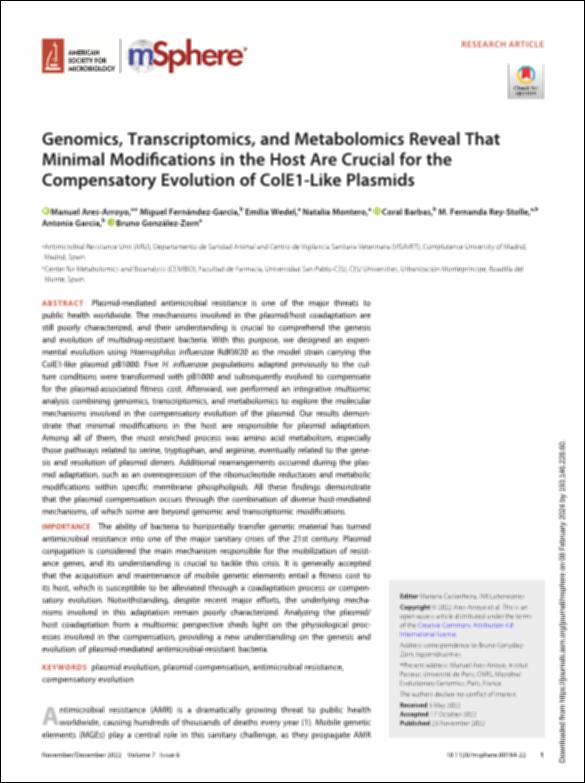Por favor, use este identificador para citar o enlazar este ítem:
http://hdl.handle.net/10637/15429Genomics, Transcriptomics, and Metabolomics Reveal That Minimal Modifications in the Host Are Crucial for the Compensatory Evolution of ColE1-Like Plasmids
| Título : | Genomics, Transcriptomics, and Metabolomics Reveal That Minimal Modifications in the Host Are Crucial for the Compensatory Evolution of ColE1-Like Plasmids |
| Autor : | Ares-Arroyo, Manuel Fernández García, Miguel Wedel, Emilia Montero, Natalia Barbas Arribas, Coral. Rey-Stolle, María Fernanda García Fernández, Antonia González Zorn, Bruno |
| Materias: | Antimicrobial resistance; Compensatory evolution; Plasmid compensation; Plasmid evolution. |
| Editorial : | American Society for Microbiology |
| Citación : | Ares-Arroyo M, Fernández-García M, Wedel E, Montero N, Barbas C, Rey-Stolle MF, Garcia A, González-Zorn B. Genomics, Transcriptomics, and Metabolomics Reveal That Minimal Modifications in the Host Are Crucial for the Compensatory Evolution of ColE1-Like Plasmids. mSphere. 2022 Dec 21;7(6):e0018422. doi: 10.1128/msphere.00184-22. Epub 2022 Nov 23. PMID: 36416553; PMCID: PMC9769657. |
| Resumen : | Plasmid-mediated antimicrobial resistance is one of the major threats to public health worldwide. The mechanisms involved in the plasmid/host coadaptation are still poorly characterized, and their understanding is crucial to comprehend the genesis and evolution of multidrug-resistant bacteria. With this purpose, we designed an experimental evolution using Haemophilus influenzae RdKW20 as the model strain carrying the ColE1-like plasmid pB1000. Five H. influenzae populations adapted previously to the culture conditions were transformed with pB1000 and subsequently evolved to compensate for the plasmid-associated fitness cost. Afterward, we performed an integrative multiomic analysis combining genomics, transcriptomics, and metabolomics to explore the molecular mechanisms involved in the compensatory evolution of the plasmid. Our results demonstrate that minimal modifications in the host are responsible for plasmid adaptation. Among all of them, the most enriched process was amino acid metabolism, especially those pathways related to serine, tryptophan, and arginine, eventually related to the genesis and resolution of plasmid dimers. Additional rearrangements occurred during the plasmid adaptation, such as an overexpression of the ribonucleotide reductases and metabolic modifications within specific membrane phospholipids. All these findings demonstrate that the plasmid compensation occurs through the combination of diverse host-mediated mechanisms, of which some are beyond genomic and transcriptomic modifications. IMPORTANCE The ability of bacteria to horizontally transfer genetic material has turned antimicrobial resistance into one of the major sanitary crises of the 21st century. Plasmid conjugation is considered the main mechanism responsible for the mobilization of resistance genes, and its understanding is crucial to tackle this crisis. It is generally accepted that the acquisition and maintenance of mobile genetic elements entail a fitness cost to its host, which is susceptible to be alleviated through a coadaptation process or compensatory evolution. Notwithstanding, despite recent major efforts, the underlying mechanisms involved in this adaptation remain poorly characterized. Analyzing the plasmid/host coadaptation from a multiomic perspective sheds light on the physiological processes involved in the compensation, providing a new understanding on the genesis and evolution of plasmid-mediated antimicrobial-resistant bacteria. |
| URI : | http://hdl.handle.net/10637/15429 |
| Derechos: | http://creativecommons.org/licenses/by-nc-nd/4.0/deed.es OpenAccess |
| ISSN : | 2379-5042 |
| Fecha de publicación : | 21-dic-2022 |
| Centro : | Universidad San Pablo-CEU |
| Aparece en las colecciones: | Medicina |
Los ítems de DSpace están protegidos por copyright, con todos los derechos reservados, a menos que se indique lo contrario.


